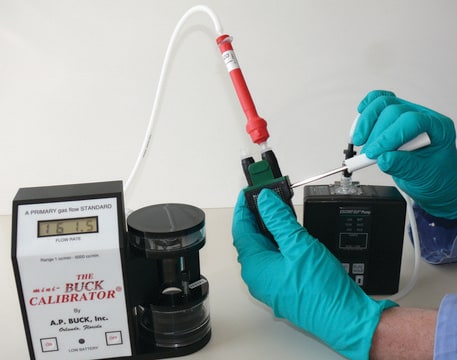29532-U
Carbotrap® 300 Thermal Desorption Tube
glass, O.D. x I.D. x L 1/4 in. × 3 1/2 in., fritted, preconditioned, pkg of 10 ea
About This Item
Produtos recomendados
product name
Carbotrap® 300, glass TD tube, fritted, O.D. × L 1/4 in. × 3 1/2 in., preconditioned, pkg of 10 ea
Materiais
glass TD tube
Agency
EPA TO-1,TO-2,TO-3,TO-17
descrição
Sealed with TDS³ Storage Container
linha de produto
Carbotrap®
Características
fritted
preconditioned
embalagem
pkg of 10 ea
características do produto alternativo mais ecológico
Waste Prevention
Safer Solvents and Auxiliaries
Learn more about the Principles of Green Chemistry.
sustainability
Greener Alternative Product
técnica(s)
active air sampling: suitable
D.E. × C
1/4 in. × 3 1/2 in.
matriz
Carbosieve S-III carbon molecular sieve (CMS)
Carbotrap® 300 (Packed with Carbotrap C, Carbotrap B, Carbosieve SIII)
Carbotrap® C graphitized carbon black (GCB)
Carbotrap® graphitized carbon black (GCB)
aplicação(ões)
air monitoring
environmental
industrial hygiene
compatibilidade
for use with PerkinElmer, Markes, DANI, OI Analytical, and Shimadzu Instruments
categoria alternativa mais ecológica
Procurando produtos similares? Visita Guia de comparação de produtos
Descrição geral
Informações legais
Código de classe de armazenamento
11 - Combustible Solids
Classe de risco de água (WGK)
nwg
Ponto de fulgor (°F)
Not applicable
Ponto de fulgor (°C)
Not applicable
Escolha uma das versões mais recentes:
Certificados de análise (COA)
Lamentamos, não temos COA para este produto disponíveis online no momento.
Se precisar de ajuda, entre em contato Atendimento ao cliente
Já possui este produto?
Encontre a documentação dos produtos que você adquiriu recentemente na biblioteca de documentos.
Nossa equipe de cientistas tem experiência em todas as áreas de pesquisa, incluindo Life Sciences, ciência de materiais, síntese química, cromatografia, química analítica e muitas outras.
Entre em contato com a assistência técnica







